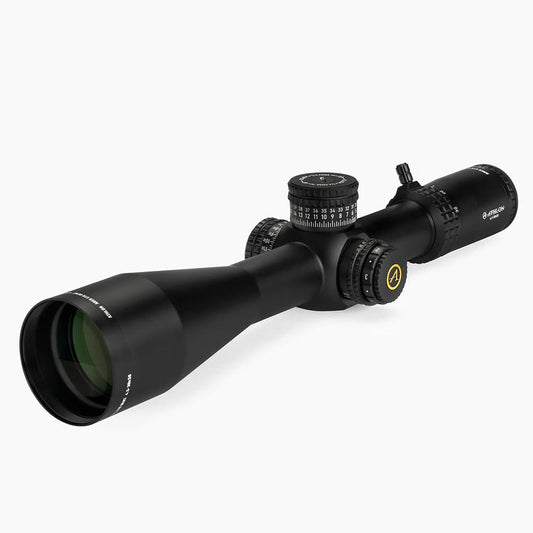

Athlon Ares ETR Gen 2 UHD Rifle Scope 4.5-30x56 34mm FFP APLR12 MOA Illuminated delivers impressive performance with its Ultra High-Definition glass, designed for optimal light transmission and clarity. This scope supports long-range shooting and hunting, ensuring you can clearly see your target from a distance. Its robust construction is built to endure tough conditions while providing features like a precision zero stop for quick adjustments and an illuminated reticle for enhanced visibility in low-light settings.
Available in both MIL and MOA configurations, this scope accommodates various shooting preferences. The combination of advanced optics and durable design makes it a reliable choice for both novices and experienced shooters. Elevate your shooting experience with a scope that meets the demands of precision and performance.
Features:
- ULTRA HIGH-DEFINITION GLASS for exceptional light transmission and clarity, ensuring every shot is precise.
- PRECISION ZERO STOP allows for quick and accurate adjustments, perfect for long-range applications.
- ILLUMINATED RETICLE enhances visibility in low-light environments, giving you an edge in all conditions.
- RUGGED DESIGN withstands harsh conditions, making it ideal for hunting and competitive shooting.
- FIRST FOCAL PLANE (FFP) retains reticle size at any magnification, providing accurate range estimation at all times.
- ADJUSTABLE EYE RELIEF ensures comfort and ease of use, accommodating various shooting styles.
- WIDE MAGNIFICATION RANGE (4.5-30x) allows for versatile applications, from short to long-range shooting.
- MOA AND MIL OPTIONS available to suit your preference for measurements, enhancing shooting accuracy.
Technical Specifications Table
| Specification | Details |
|---|---|
| Magnification | 4.5-30x |
| Lens Diameter | 56 mm |
| Tube Diameter | 34 mm |
| Weight | 30 oz |
| Length | 16.5 inches |
| Material | Aircraft-grade aluminum |
What’s in the Box?
- Lens covers
- Padded scope case
- User manual
- Neck strap
Customer Reviews
"The clarity is unmatched, and the illuminated reticle is a game-changer for low-light shooting!"
"I love the precision zero stop feature; it makes adjustments effortless during competitions."
"This scope is rugged and reliable—perfect for my hunting trips!"
FAQ
How does the Ares ETR perform in low-light conditions? The illuminated reticle significantly enhances visibility, making it ideal for dawn or dusk hunting.
How do I maintain the Athlon Ares ETR Rifle Scope? Regularly clean the lenses with a soft cloth, and store it in a protective case to avoid scratches and damage.
What is the difference between MOA and MIL versions? MOA (Minutes of Angle) and MIL (Milliradian) are different measurement systems for adjustments. Choose based on your preference for precision.
Similar Models
Looking for more high-quality optics? Discover our extensive Athlon lineup, including models like the Athlon Midas BTR 1-8x28 for versatility and the Athlon Argos BTR 6-24x50 for enhanced precision. Explore our full collection for exceptional scopes tailored to your shooting adventures.
You May Also Like
Here’s some of our most similar products people are buying. Click to discover trending style.






